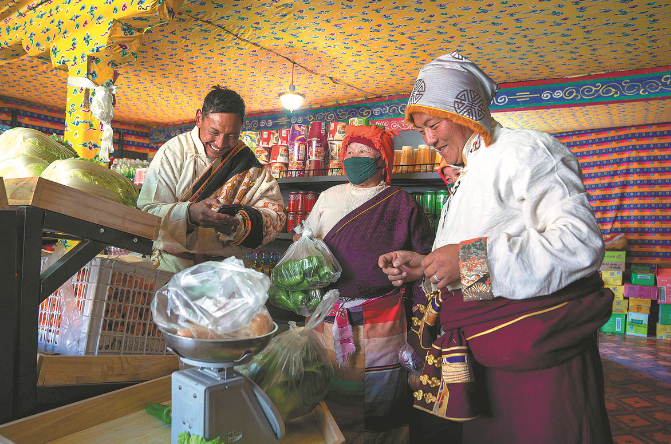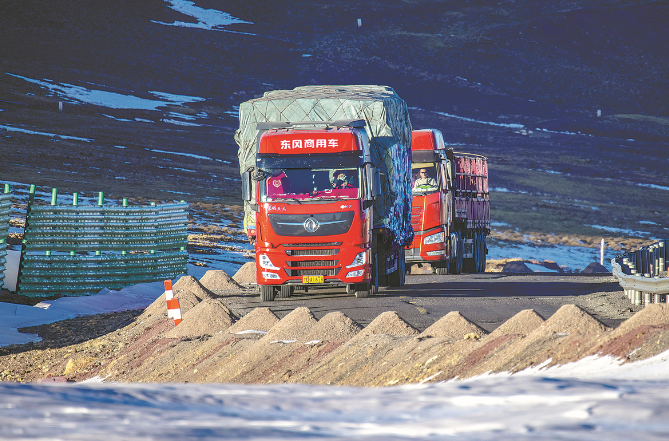Project helps bring produce to rural area in Xizang
Updated: 2024-02-01 (China Daily)  Print
Print 



Tibetan villagers purchase fresh vegetables at a grocery store in a remote village in Shanza county, Xizang autonomous region, on Jan 6. TENZIN NIMACHOQU/XINHUA
LHASA — In the remote pastoral areas of Shanza county in Southwest China's Xizang autonomous region, fresh fruits and vegetables have become a common sight for Wu Wa — a stark contrast from Wu's childhood, when apples were once a rare treat and green vegetables were hardly ever seen on the dining table.
Spanning over 25,000 square kilometers, the county is nestled in the heart of the Qinghai-Tibet Plateau and stands at an average altitude of about 4,700 meters.
Nearly 90 percent of Shanza's 23,000 people are engaged in animal husbandry.
The harsh combination of a cold climate, barren land and high altitude posed significant challenges for the cultivation of fruits and vegetables in the area, so the locals had to rely on meat and dairy products as the main components of their diet.
In 2019, the regional department of commerce launched a pilot project for fruit and vegetable distribution in Shanza. With an investment of nearly 3 million yuan ($422,000), a fresh produce storage facility was built, 16 produce stands were set up across the county and refrigeration equipment and transport vehicles were purchased.
As part of the initiative, fresh produce and essential items were packaged and transported to the county from the regional capital Lhasa, nearly 600 kilometers away, and sometimes even from Xining, the capital of neighboring Qinghai province. The goods were then distributed to vendors in towns and villages.
"We can now enjoy fresh items such as dragon fruit, kiwi fruit and cherries, and we can always have vegetables with our meals," Wu said.

Trucks deliver fresh fruits and vegetables from Xining, Qinghai province, to Shanza on Jan 3. CAO BIN/XINHUA
The project has been well-received among residents, and there are now 44 produce stands in the county.
Every year, the county government allocates 70,000 yuan to subsidize the daily operations and fuel costs for vendors in a bid to keep produce prices consistent, according to Ma Yulong, deputy director of the county's economy and information technology bureau.
It used to take two days for produce to be delivered from Lhasa to Shanza. Now, a truck laden with 20 metric tons of fresh produce such as peppers, potatoes, cabbage, tangerines, grapes and apples usually sets off from Lhasa at 7 or 8 pm, reaching Shanza in about 12 hours.
The enhanced transportation system has ensured the freshness of the produce, said Tonzhub, an official with the county's supply and marketing cooperatives, which is responsible for carrying out the project.
Shere Gyatso, who operates a produce stand, said he receives shipments two to three times a week, each weighing about 50 kilograms.
"I notify the villagers in our WeChat group as soon as the fresh produce arrives. The demand from villagers has increased, and occasionally I have to restock the supplies," he said, adding that apples and cabbage are the most sought-after items.
Last year, Shere Gyatso took part in a training program organized by the county's supply and marketing cooperatives to learn about fruit and vegetable preservation techniques. "These skills have helped me overcome previous problems I faced in preservation. I can replenish my stock with more varieties and offer more options for the villagers," he said.
A total of 218 tons of fresh fruits and vegetables were distributed to households in the county last year as a result of the pilot project, accounting for 30 percent of the county's fruit and vegetable consumption.








